Memory-keeping methods can be powerful tools for managing anxiety. They offer you creative outlets to express emotions, reflect on positive experiences, and track your progress. Through mindful journaling, anxiety-soothing photo albums, and gratitude logs, you'll gain insight into your triggers and develop coping strategies. Scrapbooking and art therapy provide calming activities that redirect your focus from anxious thoughts. Memory jars and sensory-focused techniques help you revisit comforting moments during stressful times. Collaborative projects foster connection and support, reducing feelings of isolation. By engaging in these practices, you'll build resilience and cultivate a more positive mindset. Explore these methods to discover which ones resonate with you most.
Mindful Journaling for Anxiety Relief
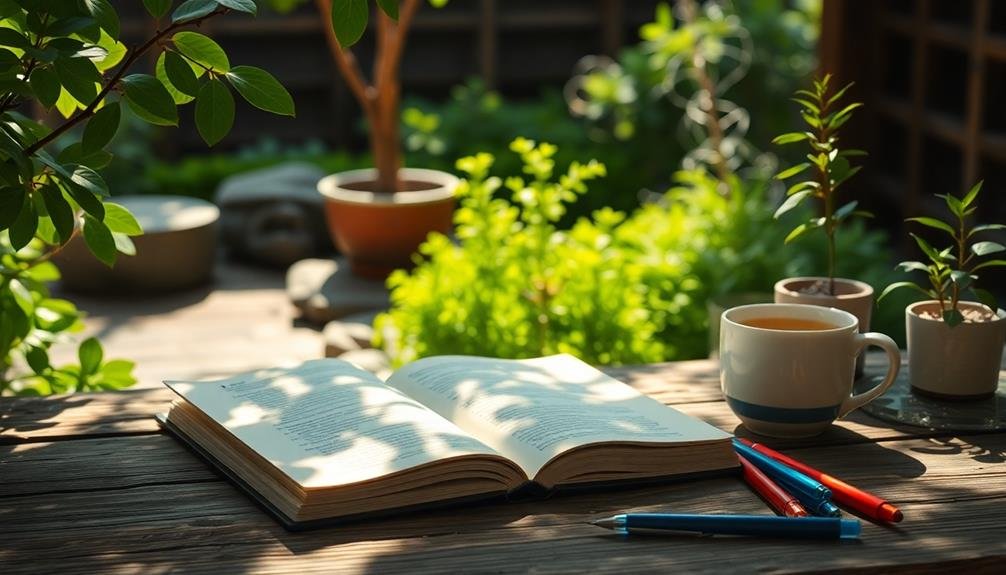
In recent years, mindful journaling has emerged as a powerful tool for managing anxiety. This practice involves writing down your thoughts, feelings, and experiences with a focus on the present moment. By dedicating time to reflect on your day-to-day life, you can gain valuable insights into your anxiety triggers and patterns.
To start mindful journaling, set aside a few minutes each day to write freely without judgment. Focus on describing your current emotions, physical sensations, and surroundings in detail. Pay attention to any anxious thoughts that arise, but try to observe them objectively rather than getting caught up in them.
As you continue this practice, you'll likely notice patterns in your anxiety and develop a better understanding of what triggers it. This awareness can help you create more effective coping strategies and make informed decisions about managing your mental health.
Additionally, mindful journaling can serve as a form of emotional release, allowing you to express and process difficult feelings in a safe, private space. Over time, you may find that this practice reduces the intensity of your anxiety symptoms and improves your overall well-being.
Creating Anxiety-Soothing Photo Albums
Creating anxiety-soothing photo albums can be a powerful tool for managing your stress and cultivating positive memories.
You'll want to select images that evoke a sense of calm and comfort, focusing on themes that bring you joy and relaxation.
As you organize your album, group photos based on the positive emotions they inspire, and consider adding brief, soothing captions to enhance the calming effect of each image.
Choose Comforting Visual Themes
When selecting visual themes for your anxiety-soothing photo albums, prioritize images that evoke calm and positive emotions. Choose colors, patterns, and subjects that resonate with your personal sense of tranquility. Soft, muted tones like pastels or earthy hues can create a soothing atmosphere, while nature scenes often promote relaxation and grounding.
Consider incorporating these comforting visual themes into your photo albums:
- Serene landscapes: Beaches, forests, mountains, or peaceful gardens
- Gentle animal imagery: Sleeping pets, grazing wildlife, or aquarium scenes
- Nostalgic memorabilia: Childhood toys, family heirlooms, or vintage objects
- Abstract patterns: Flowing water, geometric shapes, or soft textures
As you curate your album, focus on images that trigger positive memories or aspirations. Include photos of loved ones, favorite places, or moments of personal achievement.
You can also add inspirational quotes or affirmations that complement the visual themes. Remember, the goal is to create a personalized collection that serves as a visual refuge during anxious moments, offering comfort and reassurance whenever you need it.
Organize by Positive Emotions
Organizing your anxiety-soothing photo album by positive emotions can amplify its therapeutic effect. Instead of arranging photos chronologically, group them based on the feelings they evoke. Create sections for joy, calm, love, gratitude, and accomplishment. This approach helps you focus on positive experiences and emotions when anxiety strikes.
For your joy section, include photos of celebrations, laughter with friends, or moments that made you smile. The calm section might feature serene landscapes, peaceful moments at home, or images of your favorite relaxation activities. Fill the love section with pictures of family, pets, and close friends. In the gratitude area, add photos representing things you're thankful for, like a comfortable home or a supportive colleague. Finally, the accomplishment section should showcase your achievements, big and small.
As you organize your album, take time to reflect on each photo and the positive emotion it represents. This process itself can be soothing and help shift your focus away from anxious thoughts.
When you're feeling overwhelmed, you can turn to specific sections that align with the emotional support you need most in that moment.
Include Calming Captions
To enhance the soothing effect of your photo album, consider adding calming captions to each image. These captions can serve as gentle reminders of positive moments and help ground you during anxious times.
When crafting your captions, focus on words and phrases that evoke a sense of peace and tranquility.
Choose captions that resonate with you personally and align with your anxiety management strategies. You might opt for:
- Short, mindful affirmations like "Breathe deeply" or "This moment is yours"
- Quotes from favorite books or inspirational figures that bring you comfort
- Brief descriptions of the positive feelings associated with the image
- Simple reminders of your personal strengths or accomplishments
As you browse through your album, these captions will work in tandem with the visual memories to create a more immersive, calming experience.
They'll help reinforce positive associations and provide additional emotional support when you need it most.
Therapeutic Benefits of Scrapbooking
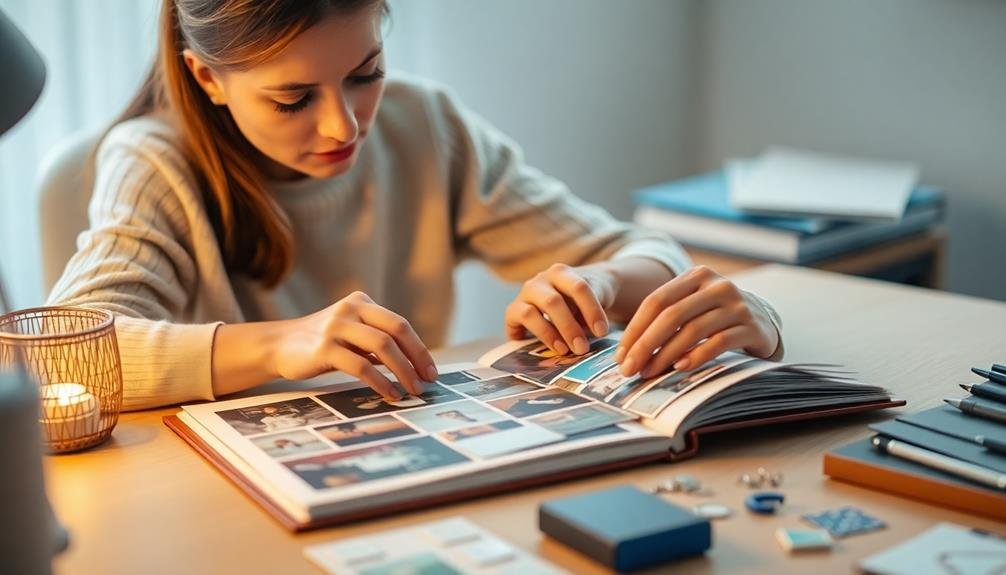
Scrapbooking offers you a calming creative outlet that can soothe anxiety while preserving positive memories.
As you craft and arrange your personal mementos, you're engaging in a mindful activity that keeps you focused on the present moment.
This hands-on approach to memory-keeping can help you build a tangible reminder of life's joyful experiences, serving as a powerful tool for managing anxiety and boosting your mood.
Calming Creative Outlet
Crafting memories through scrapbooking can be a powerful therapeutic tool for those struggling with anxiety. As you immerse yourself in this creative process, you'll find it offers a calming outlet for your thoughts and emotions.
The act of arranging photos, choosing colors, and adding personal touches can help redirect your focus from anxious thoughts to the present moment.
Scrapbooking as a calming creative outlet provides several benefits:
- Mindfulness practice: It encourages you to be fully present, engaging your senses and promoting relaxation.
- Emotional expression: You can explore and process your feelings through visual storytelling.
- Sense of accomplishment: Completing pages or projects boosts self-esteem and confidence.
- Stress reduction: The repetitive nature of cutting, gluing, and arranging can have a meditative effect.
Preserving Positive Memories
Often overlooked, the therapeutic power of preserving positive memories through scrapbooking can be transformative for anxiety sufferers. By creating a tangible record of happy moments, you're building a powerful tool to combat anxiety's negative thought patterns. When you're feeling overwhelmed, flipping through your scrapbook can provide instant relief and perspective.
Scrapbooking offers a structured way to process and celebrate positive experiences. As you arrange photos, tickets, and mementos, you're reinforcing neural pathways associated with joy and contentment. This practice can help rewire your brain to focus more on positive aspects of life, even during challenging times.
Here's a quick guide to get you started:
| Materials | Techniques |
|---|---|
| Photos | Journaling |
| Decorative paper | Layering |
| Stickers | Sketching |
| Washi tape | Stamping |
| Memorabilia | Mixed media |
Mindfulness Through Crafting
Beyond preserving memories, scrapbooking serves as a powerful mindfulness tool for anxiety sufferers. As you engage in this creative process, you're forced to focus on the present moment, quieting the anxious thoughts that often plague your mind. The act of arranging photos, choosing colors, and adding embellishments requires your full attention, effectively grounding you in the here and now.
Scrapbooking offers several therapeutic benefits that can help manage anxiety:
- Stress reduction: The repetitive nature of cutting, pasting, and decorating can be incredibly calming.
- Emotional processing: Reflecting on memories while crafting allows you to process emotions in a safe, controlled environment.
- Sense of accomplishment: Completing a scrapbook page provides a tangible sense of achievement.
- Improved self-esteem: Creating something beautiful boosts confidence and self-worth.
As you immerse yourself in scrapbooking, you'll find that it's not just about preserving memories, but also about creating a mindful practice that can help alleviate anxiety symptoms.
The tactile nature of working with paper, glue, and various materials engages your senses, promoting a state of flow that can be deeply therapeutic.
Memory Jars for Positive Moments
Memory jars serve as tangible reminders of positive experiences for anxiety sufferers. They're simple to create and can be a powerful tool in managing anxiety symptoms.
To start, choose a clear jar or container that you can easily see into. Whenever you experience a positive moment, write it down on a small piece of paper and add it to the jar.
These moments can be anything from receiving a compliment to accomplishing a task you've been putting off. The key is to focus on the positive aspects of your day, no matter how small they may seem. As you fill your jar, you'll create a visual representation of the good things in your life.
When anxiety strikes, you can turn to your memory jar for comfort. Read through the notes to remind yourself of the positive experiences you've had. This practice can help shift your focus from anxious thoughts to more positive ones.
You might even find patterns in the types of experiences that bring you joy, allowing you to seek out similar situations in the future.
Digital Collages as Coping Mechanisms
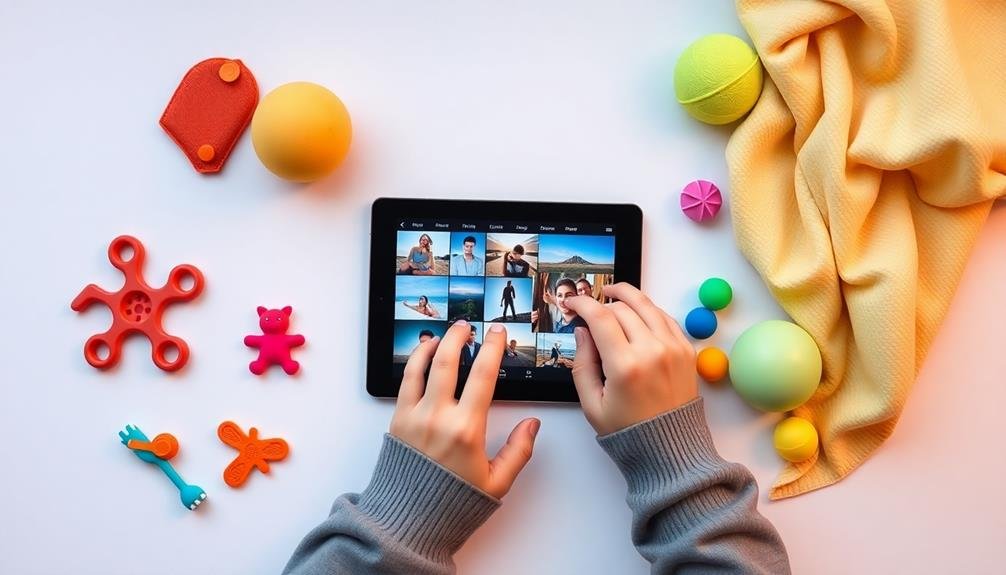
Digital collages offer you a powerful way to express your emotions visually when words fail.
You'll find that creating these digital art pieces can help organize your scattered thoughts and bring clarity to your feelings.
As you build your collection over time, you're creating a visual record of your journey, allowing you to track your progress creatively and see how far you've come in managing your anxiety.
Express Emotions Visually
Creativity offers a powerful outlet for anxiety sufferers to express their emotions visually. When words fail to capture your inner turmoil, turning to visual expression can provide relief and clarity. By creating art that represents your feelings, you're able to externalize your anxiety and gain a new perspective on your emotions.
Visual expression isn't limited to traditional art forms. You can explore various mediums to find what resonates with you:
- Painting or drawing: Use colors and shapes to represent your emotional state
- Photography: Capture images that reflect your mood or anxious thoughts
- Sculpture: Create three-dimensional representations of your feelings
- Mixed media: Combine different materials to express complex emotions
Don't worry about artistic skill; the goal is self-expression, not perfection. As you engage in visual art-making, you'll likely find that the process itself is therapeutic.
The act of creating can help calm your mind and provide a sense of control over your anxiety. Additionally, your finished pieces serve as tangible reminders of your emotional journey, allowing you to track your progress and growth over time.
Organize Scattered Thoughts
In the midst of anxiety, your thoughts can feel like a whirlwind of chaos. Digital collages offer a unique way to organize these scattered thoughts and create a visual representation of your mental state. By combining images, text, and digital elements, you can externalize your internal experiences and gain a clearer perspective on your anxiety.
Start by collecting images that resonate with your feelings or experiences. These can be personal photos, stock images, or abstract art. Next, add text snippets that capture your thoughts or worries. Use digital tools to arrange these elements on a canvas, creating a visual narrative of your anxiety.
As you build your collage, you'll find patterns emerging, helping you make sense of your emotions. This process not only helps organize your thoughts but also serves as a coping mechanism. The act of creating allows you to distance yourself from overwhelming emotions and gain control over your narrative.
You can revisit and modify your collages as your anxiety evolves, tracking your progress and identifying triggers. By transforming scattered thoughts into tangible digital art, you're taking a proactive step towards managing your anxiety and preserving your experiences.
Track Progress Creatively
Journaling takes on a new dimension when you incorporate digital collages as a tool for tracking your progress in managing anxiety. By combining images, text, and designs, you're creating a visual representation of your journey. This creative approach allows you to express emotions and experiences that might be difficult to put into words alone.
To get started with digital collages for anxiety management:
- Choose a digital platform or app that suits your needs, such as Canva, PicCollage, or Adobe Spark.
- Collect images that resonate with your emotions, goals, and achievements.
- Incorporate text elements to describe your feelings, affirmations, or milestones.
- Arrange your collage elements in a way that tells your story and showcases your progress.
As you create these visual journals, you'll notice patterns in your anxiety triggers and coping mechanisms.
Over time, you'll build a collection of digital artifacts that not only document your journey but also serve as reminders of your resilience and growth. This creative process can be both therapeutic and empowering, giving you a tangible way to see how far you've come in managing your anxiety.
Anxiety-Friendly Bullet Journaling Techniques
Bullet journals can be a powerful tool for anxiety sufferers, but traditional methods may feel overwhelming. To make bullet journaling more anxiety-friendly, simplify your approach. Start with a basic layout that includes only essential elements like a monthly calendar, daily log, and habit tracker. Use color-coding to categorize tasks and emotions, making it easier to identify patterns and triggers.
Instead of long-form entries, opt for brief bullet points or simple symbols to represent your thoughts and experiences. This reduces the pressure to write extensively and allows for quick, stress-free updates. Create a dedicated "anxiety log" section where you can jot down specific anxious thoughts or situations as they arise. This helps you track your anxiety over time and identify potential triggers.
Incorporate mindfulness exercises directly into your journal, such as breathing techniques or short gratitude lists. These can serve as quick anxiety-relief tools when needed.
Don't aim for perfection in your layouts or handwriting; embrace imperfections and focus on the process rather than the end result. Remember, your bullet journal is a personal tool for managing anxiety, not a showcase for artistic skills.
Gratitude Logs for Mental Health

While gratitude logs are beneficial for everyone, they can be particularly powerful for those struggling with anxiety and other mental health issues. By focusing on positive aspects of your life, you're training your brain to shift away from anxious thoughts and appreciate the good around you.
Gratitude logs can be as simple as jotting down three things you're thankful for each day, or they can be more detailed reflections on specific experiences.
To make the most of your gratitude log, try these techniques:
- Be specific: Instead of writing "family," note "Mom's supportive phone call today."
- Include small joys: Acknowledge simple pleasures like a warm cup of tea or a sunny day.
- Reflect on challenges: Find silver linings in difficult situations to reframe your perspective.
- Use all your senses: Describe the sights, sounds, and feelings associated with your gratitude entries.
Consistency is key when maintaining a gratitude log.
You'll likely notice improvements in your mood and anxiety levels over time as you develop a habit of recognizing and appreciating the positive aspects of your life.
Art Therapy Through Memory Books
Art therapy offers a creative outlet for anxiety sufferers to express their emotions and memories through visual means. Creating a memory book through art can be a powerful tool for managing anxiety and preserving important moments. You don't need to be an artist to benefit from this practice; simple sketches, collages, or even abstract designs can effectively capture your experiences.
Start by selecting a blank journal or scrapbook, and dedicate it to your art therapy journey. Use various mediums like colored pencils, markers, or watercolors to illustrate your memories, feelings, or thoughts. You can incorporate photographs, ticket stubs, or other mementos to enhance your visual storytelling.
As you work on your memory book, focus on the process rather than the end result. Allow yourself to explore your emotions freely without judgment. This creative practice can help you gain new perspectives on past experiences, reduce stress, and improve your overall mental well-being.
Sensory-Focused Memory Keeping Methods
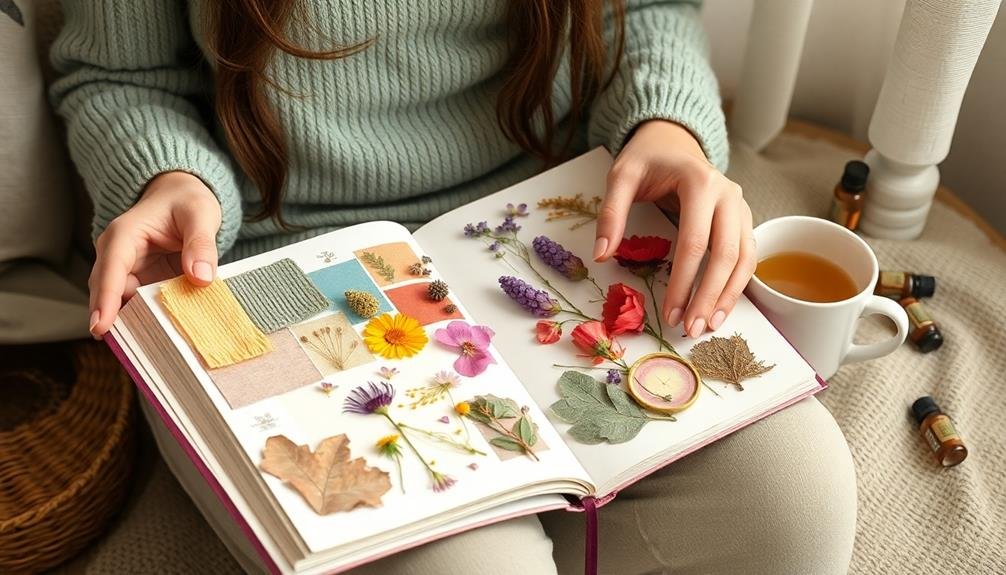
Sensory-focused memory keeping methods offer a unique approach to preserving experiences for anxiety sufferers. By engaging multiple senses, you can create more vivid and calming memories that help ground you during anxious moments.
These techniques involve capturing not just visual elements, but also sounds, smells, textures, and even tastes associated with positive experiences.
To incorporate sensory-focused memory keeping into your routine, try these methods:
- Create a sensory memory box filled with items that trigger positive memories, such as seashells from a beach vacation or a small bottle of your favorite perfume.
- Record ambient sounds from peaceful moments or locations, like rainfall or ocean waves, to replay when you need to relax.
- Keep a texture journal where you collect and describe different tactile sensations that bring you comfort, such as smooth stones or soft fabrics.
- Develop a scent library using essential oils or small fragrance samples that remind you of pleasant experiences or calming environments.
Collaborative Memory Projects for Support
Teamwork can be a powerful tool in managing anxiety and preserving memories. By engaging in collaborative memory projects, you'll not only create lasting mementos but also build a support network that understands your struggles.
Consider starting a group scrapbook with friends who also experience anxiety. Each member can contribute pages that represent their experiences, coping strategies, and positive moments. This shared project allows you to see that you're not alone in your journey and provides inspiration from others' successes.
Another option is to create a digital memory vault with family members. Use a shared cloud storage service to upload photos, videos, and written reflections about your collective experiences. This collaborative effort helps you focus on positive memories and reinforces family bonds.
You might also join an online community for anxiety sufferers who enjoy memory keeping. Participate in monthly challenges, share your creations, and offer support to others. This virtual collaboration can help you feel connected and motivated to continue your memory-keeping practices, even on difficult days.
Frequently Asked Questions
How Long Does It Take to See Results From Memory-Keeping Methods?
You'll likely see results from memory-keeping methods within a few weeks to a couple of months. Consistency is key. You're building new habits, so give yourself time to adapt and notice improvements in your memory and overall well-being.
Can Memory-Keeping Techniques Replace Professional Therapy for Anxiety?
Memory-keeping techniques can't replace professional therapy for anxiety. While they're helpful tools, you shouldn't rely on them as your sole treatment. It's best to use these methods alongside therapy for a thorough approach to managing your anxiety.
Are There Any Potential Drawbacks to Using Memory-Keeping Methods?
While memory-keeping can be helpful, you might find it triggers negative emotions or becomes obsessive. It's not a substitute for professional help and could lead to overanalyzing past experiences. You shouldn't rely on it as your sole coping mechanism.
What Age Groups Benefit Most From These Anxiety-Reducing Memory Techniques?
You'll find these anxiety-reducing memory techniques beneficial at any age. They're especially effective for teens and young adults dealing with school stress, and older adults facing life changes. Don't hesitate to start using them, regardless of your age.
How Can Memory-Keeping Methods Be Incorporated Into a Busy Daily Routine?
You can easily incorporate memory-keeping into your busy day. Try jotting down quick notes during breaks, using voice memos while commuting, or setting a reminder to snap a daily photo. It's about finding small, manageable moments.
In Summary
You've now discovered various memory-keeping methods that can help manage your anxiety. By embracing these creative techniques, you're not only preserving precious moments but also building powerful tools for emotional regulation. Whether it's journaling, scrapbooking, or creating digital collages, you're actively engaging in self-care. Remember, these practices aren't just about looking back; they're about moving forward with greater resilience. So pick a method that resonates with you and start your healing journey today.

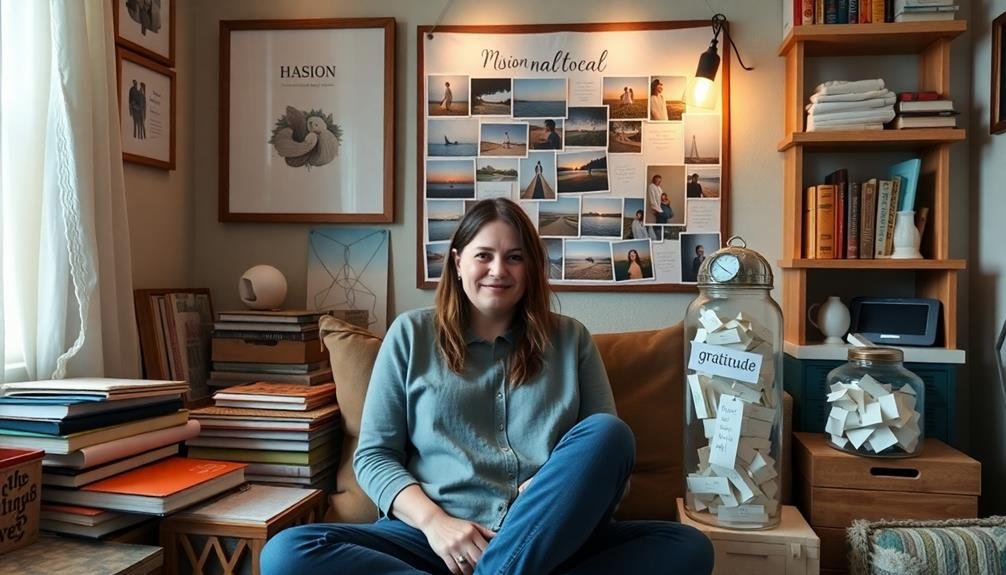



Leave a Reply